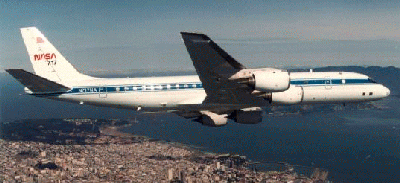

Length: 157 feet
Wingspan: 148 feet
Engine: Four CFM56-2-C1 High Bypass Turbofan Jet
Base: Ames Research Center, Moffett Field, CA
PERFORMANCE: Altitude: 1,000 - 41,000 feet
Range: 5,400 Nautical miles
Duration: 12 hours
Speed: 425 - 490 knots True Air Speed(cruise)
Payload: 30,000 lb.
ACCOMMODATIONS: Zenith, 8 and 62 Deg, and Nadir Viewports
External Antenna Attachment Mounts
Wing Pylons
Optical Windows
Gyro Stabilized Mirror System
Dropsonde Delivery Tube
Air and Aerosol Sampling Probes
Standard Equipment Racks 19-inch
Laser Chiller Unit
SUPPORT: Dew/Frost Point Hygrometer
Radar Altimeter
Weather Radar
GPS and Inertial Navigational Systems
Time Code Generator
Closed Circuit Television
Data Acquisition
Metric Cameras
Both 400 Hz and 60 Hz Power
Ten to Twelve Stations Available for Investigators
Data gathered at flight altitude and by remote sensing from the DC-8 have been used in many studies including: archeology, ecology, geology, hydrology, meteorology, oceanography, volcanology, atmospheric chemistry, soil science, biology,other earth science disciplines.
The DC-8 is one of several aircraft based at NASA-Ames that support NASA's Airborne Science and Applications Program. These research aircraft include three ER-2 (Earth Resources) high altitude aircraft, the C-130B Earth Science Aircraft, and a C-141 airborne infrared observatory.
Scientific investigators use the aircraft for earth, atmospheric and celestial observations.
Research includes development of new sensors, and methodology for conducting such observations. Data from operational sensors as well as newly developed instruments are used in applications programs examining subjects such as ozone depletion, tropical rain forest destruction, tropical disease vectors, wildfire investigations and geologic remote sensing.
Precision Thermal Radiometer (PRT-5)
A Barnes Engineering Co. PRT-5 nadir viewing infrared radiometer system, featuring a thermistor bolometer detector in a reference temperature cavity, measures earth's surface (land or water) or cloud-top temperatues. The radiometer has a 2 degree field of view, and has auto-ranging capability over three temperatue ranges covering -80C to +55C.
The General Eastern 1011A is a two-stage thermo-electically cooled mirror hygrometer system designed to obtain in-flight measurements of the prevailing ambient dew/frost point temperature over the range of -65C to +50C.
An EG&G Model 300 three-stage, cooled mirror hygrometer system is also operational on the DC-8 with the extended operating range of -80C to +75C.
For Missions which require photographic or video imaging, a wide variety of systems can be configured to accomplish the requirements of the Mission.
Life and Times of the NASA DC-8
A section describing the history of the DC-8 airframe will be added here.